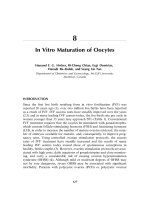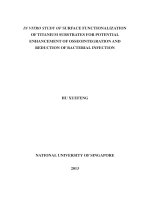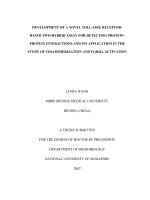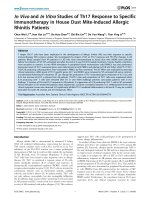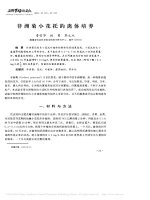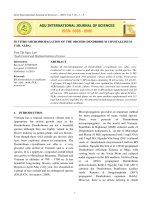In vitro study of surface functionalization of titanium substrates for potential enhancement of osseointegration and reduction of bacterial infection
Bạn đang xem bản rút gọn của tài liệu. Xem và tải ngay bản đầy đủ của tài liệu tại đây (10.18 MB, 179 trang )
IN VITRO STUDY OF SURFACE FUNCTIONALIZATION
OF TITANIUM SUBSTRATES FOR POTENTIAL
ENHANCEMENT OF OSSEOINTEGRATION AND
REDUCTION OF BACTERIAL INFECTION
HU XUEFENG
NATIONAL UNIVERSITY OF SINGAPORE
2013
IN VITRO STUDY OF SURFACE FUNCTIONALIZATION
OF TITANIUM SUBSTRATES FOR POTENTIAL
ENHANCEMENT OF OSSEOINTEGRATION AND
REDUCTION OF BACTERIAL INFECTION
HU XUEFENG
(B.Eng., M.Sci., BUCT)
A THESIS SUBMITTED
FOR THE DEGREE OF DOCTOR OF PHILOSOPHY
DEPARTMENT OF CHEMICAL AND BIOMOLECULAR
ENGINEERING
NATIONAL UNIVERSITY OF SINGAPORE
2013
DECLARATION
I hereby declare that the thesis is my original work and it has
been written by me in its entirety.
I have duly acknowledged all the sources of information which
have been used in the thesis.
This thesis has also not been submitted for any degree in any
university previously
.
Hu Xuefeng
11 June 2014
i
ACKNOWLEGEMENT
Firstly, I would like to express my sincere gratitude to my supervisor, Prof. Neoh
Koon Gee, for her thorough guidance and continuous support throughout this work.
Her critical way of thinking and enthusiastic attitude towards work has been of great
value for me. This thesis would not have been completed without her invaluable
suggestions and profound discussion.
I owe my deep gratitude to my co-supervisor, Assoc. Prof. Wilson Wang, for his
constructive comments and important support throughout this project. I am also
grateful to Prof. Kang En-Tang for his permission to access the equipment in his lab.
I would like to thank Dr. Yuan Ze Liang for his help in XPS and SEM training and
operation. I appreciate all my colleagues, Dr. Shi Zhilong, Dr. Wang Liang, Rusdianto
Budiraharjo, Tan Lihan, Yang Wenjing, Huang Chao, Wang Rong, Lu Shengjie, Zheng
Dong, Li Min and Xu Liqun, for their warm encouragement and kind help. I am also
grateful to the lab officers Ms. Li Fengmei, Ms. Li Xiang, and Dr. Yang Liming for
their assistance in my study.
Last but not least, I would like to thank my deeply beloved wife, Zhang Jieyu, for her
understanding and support. I would also like to show my gratitude to my family for
their unconditional support and love.
ii
TABLE OF CONTENTS
ACKNOWLEGEMENT
i
TABLE OF CONTENTS ii
SUMMARY vi
LIST OF TABLES viii
LIST OF FIGURES ix
NOMENCLATURE xvi
CHAPTER 1 INTRODUCTION 1
1.1 Background 2
1.2 Research objective and scope 4
CHAPTER 2 LITERATURE REVIEW 6
2.1 Introduction 7
2.2 Bone healing processes at bone-implant interface 9
2.2.1 Human body’s initial responses to an implant 9
2.2.2 Woven bone formation 10
2.2.3 Bone remodeling 11
2.3 Ti and its alloys as implant materials 12
2.3.1 Requirements for implant materials 12
2.3.2 Ti and its alloys 13
2.4 Surface modification of Ti to enhance osseointegration 14
2.4.1 Enhancement of osseointegration by surface topography 15
2.4.2 Enhancement of osseointegration by surface chemistry 16
2.5 Surface modification of Ti to reduce infections 22
2.5.1 Surface topographical modification 23
2.5.2 Surface modification with bactericidal agents 24
2.5.3 Surface modification with anti-adhesive agents 27
CHAPTER 3 BACTERIAL AND OSTEOBLAST BEHAVIOR ON Ti,
Co-Cr AND SS TREATED WITH ALKALI AND HEAT: A
COMPARATIVE STUDY FOR POTENTIAL ORTHOPEDIC
APPLICATIONS
29
3.1 Introduction 30
3.2 Materials and methods 30
iii
3.2.1 Materials 30
3.2.2 Substrate preparation 31
3.2.3 Characterization 31
3.2.4 Measurement of surface ROS density 32
3.2.5 Bacterial culture and adhesion assay 32
3.2.6 Cell culture and cytotoxic assay 33
3.2.7 Statistical analysis 34
3.3 Results and discussion 34
3.3.1 Surface characterization of the pristine and treated Ti substrates 34
3.3.2 ROS generation on the pristine and treated Ti substrates 37
3.3.3 Bacterial adhesion on the pristine and treated Ti substrates 38
3.3.4 Mammalian cell behavior on the pristine and treated Ti
substrates
41
3.3.5 Comparison with alkali and heat-treated Co-Cr and SS
substrates
44
3.4 Conclusion 50
CHAPTER 4 AN IN VITRO ASSESSMENT OF Ti FUNCTIONALIZED
WITH POLYSACCHARIDES CONJUGATED WITH VEGF FOR
ENHANCED OSSEOINTEGRATION AND INHIBITION OF
BACTERIAL ADHESION
51
4.1 Introduction 51
4.2 Materials and methods 52
4.2.1 Materials 52
4.2.2 Synthesis of CMCS and HAC 53
4.2.3 Preparation of substrates 54
4.2.4 Characterization 54
4.2.5 Bacterial adhesion assay 55
4.2.6 Cell culture 55
4.2.7 Cell attachment and proliferation 55
4.2.8 ALP activity and calcium deposition (mineralization) assay 56
4.2.9 Statistical analysis 56
4.3 Results and discussion 57
4.3.1 Surface characterization 57
4.3.2 Antibacterial properties 59
iv
4.3.3 Cell attachment and proliferation 64
4.3.4 ALP activity and calcium deposition 66
4.3.5 Stability of immobilized VEGF 69
4.4 Conclusion 71
CHAPTER 5 STRATEGY FOR IMMOBILIZING VEGF ON IMPLANT
SURFACES TO OPTIMIZE ITS CONCURRENT BIOACTIVITY
TOWARDS ENDOTHELIAL CELLS AND OSTEOBLASTS
72
5.1 Introduction 73
5.2 Materials and methods 73
5.2.1 Materials 73
5.2.2 Synthesis of HAC and HepC 74
5.2.3 Preparation of substrates 74
5.2.4 Characterization 74
5.2.5 Cell culture 75
5.2.6 Endothelial cell metabolic activity 75
5.2.7 CD31 and vWF expression 75
5.2.8 In vitro angiogenesis assay 76
5.2.9 Calcium deposition assay 77
5.2.10 Bacterial culture and adhesion assay 77
5.2.11 Statistical analysis 77
5.3 Results and discussion 78
5.3.1 HepC synthesis and substrate surface characterization 78
5.3.2 Bioactivity of the immobilized VEGF 82
5.3.3 Osteoblast mineralization 88
5.3.4 Antibacterial properties 93
5.4 Conclusion 97
CHAPTER 6 AN IN VITRO ASSESSMENT OF FIBROBLAST AND
OSTEOBLAST RESPONSE TO ALENDRONATE-MODIFIED Ti AND
THE POTENTIAL FOR DECREASING FIBROUS ENCAPSULATION
98
6.1 Introduction 99
6.2 Materials and methods 99
6.2.1 Materials 99
6.2.2 Substrate preparation 99
6.2.3 Surface characterization and alendronate release test 100
v
6.2.4 Cell culture 101
6.2.5 Cell attachment and proliferation 101
6.2.6 ALP activity assay 101
6.2.7 Apoptosis assay 101
6.2.8 Co-culture of fibroblasts and osteoblasts 102
6.2.9 Statistical analysis 102
6.3 Results and discussion 102
6.3.1 Surface characterization and alendronate release test 102
6.3.2 Fibroblast attachment, proliferation and apoptosis 106
6.3.3 Osteoblast attachment, proliferation, differentiation and
apoptosis
111
6.3.4 Co-culture of fibroblasts and osteoblasts 117
6.4 Conclusion 120
CHAPTER 7 CONCLUSIONS AND RECOMMENDATIONS FOR
FURTHER STUDY
121
7.1 Conclusions 122
7.2 Recommendations for further study 124
REFERENCES 127
LIST OF PUBLICATION 158
vi
SUMMARY
The main reasons for implant failure are defective osseointegration and bacterial
infections. Surface modification is a promising strategy to overcome these problems
since it can endow the implant surface with the desired functions while
simultaneously retaining the implant’s intrinsic mechanical properties. Since titanium
(Ti) and its alloys are the most commonly used biomaterials for implants, different
strategies for Ti surface modification to enhance osseointegration and reduce bacterial
infection have been investigated, and are reported in this thesis.
Firstly, Ti was treated with alkali and heat to convert the amorphous titanium dioxide
into anatase since anatase has been shown to exhibit antibacterial effect. The
anatase-functionalized Ti significantly reduced bacterial adhesion due to reactive
oxygen species (ROS) generated by the anatase. Unfortunately, the ROS exhibited
cytotoxicity towards osteoblasts. Cobalt-chrome (Co-Cr) alloys and stainless steel (SS)
treated in a similar fashion did not generate ROS, and exhibited no cytotoxicity
towards osteoblasts. The treated Co-Cr and SS reduced bacterial adhesion due to their
hydrophilic surfaces, which is a different mechanism from that of the alkali and
heat-treated Ti. Thus, while this strategy for Ti surface modification may be useful for
antibacterial applications, it is not deemed suitable for orthopedic applications.
A second strategy was then developed, involving covalent immobilization of a growth
factor on Ti via a pre-coated antibacterial polysaccharide layer. Vascular endothelial
growth factor (VEGF) was chosen as the target growth factor with the aim of
investigating its direct effect on osteoblasts. Antibacterial assay showed that the
polysaccharide-modified substrates significantly decreased bacterial adhesion.
Osteoblast behavior on the different substrates was also assessed, and the results
showed that osteoblast functions were enhanced by the immobilized VEGF on the
polysaccharide-grafted Ti.
Since the bioactivity of covalently immobilized VEGF may be compromised due to
adverse conformational changes and possible interference with the functional region
in the immobilization process, the possibility of bioactivity changes upon
vii
immobilization was investigated. VEGF was immobilized on Ti surfaces via either
covalent binding or heparin-VEGF interaction. The bioactivity of the covalently
immobilized VEGF on endothelial cell functions was found to be significantly lower
than that of the heparin-bound VEGF. The heparin-bound VEGF also enhanced
mineralization in an osteoblast/endothelial cell co-culture to a much greater extent
than in an osteoblast monoculture, illustrating the importance of crosstalk between
osteoblasts and endothelial cells. In addition, the surfaces of the heparin-modified
substrates are highly hydrophilic and negatively charged, which significantly inhibit
bacterial adhesion.
Lastly to address the issue of fibrous encapsulation which can impede
osseointegration, alendronate, a drug that can induce fibroblast apoptosis, was loaded
on Ti surfaces via a hydroxyapatite coating. With a surface density of loaded
alendronate of 0.05 mg/cm
2
or higher, fibroblast proliferation was suppressed due to
increased apoptosis, while osteoblast functions increased with minimal apoptosis. In a
co-culture of fibroblasts and osteoblasts in a 1:1 ratio, ~75% of the cells on these
alendronate-loaded substrates were osteoblasts four days after cell seeding. These
results suggest that the strategy of loading alendronate on Ti can potentially be
capitalized to reduce fibrous encapsulation.
viii
LIST OF TABLES
Table 3.1 Surface elemental compositions as determined by XPS, contact angle
and surface roughness of the pristine and treated Ti substrates.
Table 4.1 Elemental composition as determined by XPS and contact angle at the
surface of pristine and functionalized Ti substrates.
Table 4.2 Elemental composition as determined by XPS at the surface of the
Ti-CMCS-VEGF and Ti-HAC-VEGF substrates before and after aging
in PBS.
Table 5.1 Elemental composition as determined by XPS, contact angle, and zeta
potential at the surface of pristine and functionalized Ti substrates.
Table 5.2 Elemental composition as determined by XPS at the surface of the
Ti-HepC-VEGF substrate before and after immersion in PBS for 7 days.
Table 6.1 Elemental composition as determined by XPS, surface density of loaded
alendronate, and contact angle at the surface of the pristine and
functionalized Ti substrates.
Table 6.2 Surface density of loaded alendronate, and surface roughness of the
pristine and functionalized Ti substrates.
ix
LIST OF FIGURES
Figure 2.1 Some applications of Ti implants: total hip and knee replacements
(a), bone screws (b) and plates (c).
Figure 2.2 Schematic illustration of various causes for implant failure.
Figure 2.3 Chemical structure of BPs. R1 and R2 indicate the different side
chains.
Figure 2.4 Interaction of cells with soluble and immobilized growth factors.
Figure 3.1 Surface characterization of the pristine and treated Ti substrates. a-b:
XPS wide-scan spectra (a) and XRD spectra (b) of the pristine Ti,
TiS, TiH, TiSH, TiH-10 and TiSH-10 substrates. Į and ȡ indicate the
presence of anatase and rutile, respectively. c: FESEM images of the
pristine Ti, TiS, TiH, TiSH, TiH-10 and TiSH-10 substrates. Scale bar
= 200 nm.
Figure 3.2 Surface ROS density on the pristine Ti, TiSH and TiSH-10 substrates
after immersion in water for different periods.
Figure 3.3 Fluorescence microscopy images of S. aureus on the pristine Ti (a, d),
TiS (b, e), TiH (c, f), TiSH (g, j), TiH-10 (h, k) and TiSH-10 (i, l)
substrates after immersion in a bacterial suspension in PBS (5×10
7
cells/ml) for 4 h at 37 °C. The viable bacterial cells were stained green
while dead or membrane-compromised cells appeared red. (a-c) and
(g-i) were obtained under green filter, while (d-f) and (j-l) were
obtained under red filter. Scale bar = 100 Pm.
Figure 3.4 Number of adherent S. aureus on the different Ti substrates after
incubation with bacterial suspension in PBS (5×10
7
cells/ml) for 4 h
at 37 °C. * denotes significant difference (P < 0.05) compared with
that on pristine Ti.
Figure 3.5 SEM images of osteoblasts cultured on the pristine Ti, TiS, TiH, TiSH,
TiH-10 and TiSH-10 substrates on Days 1, 4 and 7. Scale bar = 150
μm.
Figure 3.6 Relative osteoblast metabolic activity on the different Ti substrates as
determined by MTT assay after 1, 4 and 7 days. * and # denote
significant difference (P < 0.05) compared to that on the pristine Ti
over the same incubation period and between the designated groups,
respectively. Relative osteoblast metabolic activity was calculated by
normalization of the OD obtained with the substrates with respect to
the OD obtained with pristine Ti on Day 1.
x
Figure 3.7 Surface characterization of the pristine and treated Co-Cr and SS
substrates. a-b: XPS wide-scan spectra (a) and XRD spectra (b) of
the Co-Cr, Co-CrSH, SS and SSSH substrates. F in the XRD spectra
indicates face-centered cubic. c: FESEM images and Rq values of the
Co-Cr, Co-CrSH, SS, SSSH substrates. Scale bar = 100 nm.
Figure 3.8 Number of adherent S. aureus on the different substrates after
incubation with bacterial suspension in PBS (5×10
7
cells/ml) for 4 h at
37 °C. * denotes significant difference (P < 0.05) compared with the
corresponding pristine substrates.
Figure 3.9 Fluorescence microscopy images of S. aureus on the Co-Cr (a, e),
Co-CrSH (b, f), SS (c, g) and SSSH (d, h) substrates after immersion
in a bacterial suspension in PBS (5×10
7
cells/ml) for 4 h at 37 °C. The
viable bacterial cells were stained green while dead or
membrane-compromised cells appeared red. (a-d) were obtained
under green filter, while (e-h) were obtained under red filter. Scale bar
= 100 ȝm.
Figure 3.10 Relative osteoblast metabolic activity on the different substrates as
determined by MTT assay after 1, 4 and 7 days. * denotes significant
difference (P < 0.05) between the designated groups. Relative
osteoblast metabolic activity was calculated by normalization of the
OD obtained with the substrates with respect to the OD obtained with
the corresponding pristine substrates on Day 1.
Figure 3.11 SEM images of osteoblasts cultured on the Co-Cr and Co-CrSH
substrates on Days 1, 4 and 7. Scale bar = 150 μm.
Figure 3.12
SEM images of osteoblasts cultured on the SS and SSSH substrates
on Days 1, 4 and 7. Scale bar = 150 μm.
Figure 4.1 Scheme showing the conversion of chitosan to CMCS (a), and HA to
HAC (b).
Figure 4.2 XPS wide-scan spectra of pristine Ti, Ti-Dopa, Ti-CMCS,
Ti-CMCS-VEGF, Ti-HAC, and Ti-HAC-VEGF. The concentration of
the VEGF solution used for the preparation of the Ti-CMCS-VEGF
and Ti-HAC-VEGF substrates was 1 μg/ml.
Figure 4.3 Surface density of immobilized VEGF on the surfaces of Ti-CMCS
and Ti-HAC substrates as a function of VEGF concentration in the
loading solution.
Figure 4.4 Fluorescence microscopy images of Ti (a), Ti-CMCS (b),
Ti-CMCS-VEGF (c), Ti-HAC (d), and Ti-HAC-VEGF (e) under
green filter, and Ti (f), Ti-CMCS (g), Ti-CMCS-VEGF (h), Ti-HAC
(i), and Ti-HAC-VEGF (j) under red filter, after immersion in a PBS
suspension of S. aureus (OD
600
= 0.05) for 4 h. Scale bar = 100 μm.
xi
Figure 4.5 SEM images of the freshly prepared and 21-day-aged pristine Ti,
Ti-CMCS, Ti-CMCS-VEGF, Ti-HAC, and Ti-HAC-VEGF substrates
after immersion in a PBS suspension of S. aureus (OD
600
= 0.05) for
4 h. Scale bar = 10 μm.
Figure 4.6 Number of adherent S. aureus/cm
2
on the various Ti substrates after
exposure to bacterial suspension in PBS (OD
600
= 0.05) for 4 h. *
denotes significant differences (P < 0.05) compared with pristine Ti.
Figure 4.7 SEM images of ostoblast attachment on pristine Ti (a), Ti-CMCS (b),
Ti-CMCS-VEGF (c), Ti-HAC (d), Ti-HAC-VEGF (e), and
Ti-HAC-VEGF (f) at higher magnification, 6 h after seeding. Scale
bar = 100 μm.
Figure 4.8 Cell proliferation on the pristine and functionalized Ti substrates
expressed as number of cells/cm
2
after 1, 4, and 7 days. *denotes
significant difference (P < 0.05) compared with pristine Ti.
Figure 4.9 ALP activity of osteoblasts cultured on the pristine and
functionalized Ti substrates. * denotes significant differences (P <
0.05) compared with the pristine Ti.
Figure 4.10 Optical microscopy images of Alizarin Red stained osteoblasts after
culturing for 14 days on Ti (a), Ti-CMCS (b), Ti-CMCS-VEGF (c),
Ti-HAC (d), and Ti-HAC-VEGF (e). Initial seeding was carried out
with 3×10
4
cells/cm
2
. (f) shows the Ti-CMCS substrate which had
been placed in cell culture medium for 14 days without cell seeding
after Alizarin Red staining. Scale bar = 200 μm.
Figure 4.11 Cell proliferation in transwells with or without the Ti-CMCS-VEGF
and Ti-HAC-VEGF substrates placed at the bottom of the wells.
Figure 4.12 XPS wide-scan spectra of the Ti-CMCS-VEGF and Ti-HAC-VEGF
substrates before and after aging in PBS.
Figure 5.1 Scheme showing the conversion of heparin to HepC.
Figure 5.2 FT-IR spectra of heparin and HepC.
Figure 5.3 XPS wide-scan spectra of the pristine Ti, Ti-HAC, Ti-HAC-VEGF,
Ti-HepC, and Ti-HepC-VEGF substrates. The concentration of
VEGF in the loading solution was 1 Pg/ml.
Figure 5.4 Surface density of immobilized VEGF on the Ti-HAC and Ti-HepC
substrates as a function of VEGF concentration in the loading
solution.
Figure 5.5 ECFC metabolic activity as determined by MTT assay on the pristine
and functionalized Ti substrates on Days 1, 4, and 7. * and # denote
significant difference (P < 0.05) compared with that on the pristine
xii
Ti substrate, and between the designated groups, respectively.
Figure 5.6 Fluorescence microscopy images of ECFCs stained with the
FITC-conjugated CD31 and vWF antibody on the Ti, Ti-HAC,
Ti-HAC-VEGF, Ti-HepC, and Ti-HepC-VEGF substrates after 7
days of culture. For the Control, the ECFCs on Ti were not treated
with the primary antibody. Scale bar = 100 Pm.
Figure 5.7 ECFC mRNA expression of CD31 and vWF on the pristine and
functionalized Ti substrates. * and # denote significant differences (P
< 0.05) as compared to that on pristine Ti substrate, and between the
designated groups, respectively.
Figure 5.8 Effect of the immobilized VEGF on ECFC capillary tube formation.
a-f: Microscopy images of ECFCs after incubation on Matrigel for 4
h at 37 qC. Before seeding on Matrigel, the ECFCs were cultured on
the Ti (a), Ti-HAC (b), Ti-HAC-VEGF (c), Ti-HepC (d),
Ti-HepC-VEGF (e), and Ti-HepC-VEGF-Auto (f) substrates for 7
days. Scale bar = 100 Pm. g-h: Total capillary tube lenghth (g) and
number of branch points (h) per field on the different substrates. *
and # denote significant difference (P < 0.05) as compared to that on
pristine Ti substrate, and between the designated groups,
respectively. Ti-HepC-VEGF-Auto represents the autoclaved
Ti-HepC-VEGF substrate.
Figure 5.9 Optical microscopy images of Alizarin Red stained hOBs on the Ti,
Ti-HAC, Ti-HAC-VEGF, Ti-HepC and Ti-HepC-VEGF substrates
after co-cultured with ECFCs for 7 and 21 days. Scale bar = 100 μm.
The black arrows indicate the calcium nodules.
Figure 5.10 Optical microscopy images of Alizarin Red stained hOBs on the Ti,
Ti-HAC, Ti-HAC-VEGF, Ti-HepC and Ti-HepC-VEGF substrates
after the monoculture for 7 and 21 days. Scale bar = 100 μm. The
black arrows indicate the calcium nodules.
Figure 5.11 The Ti-HepC-VEGF substrate which had been placed in cell culture
medium for 7 days without seeded cells after Alizarin Red staining.
Scale bar = 100 μm.
Figure 5.12 The amount of deposited calcium from hOB/ECFC co-culture or
hOB monoculture on the pristine and functionalized Ti substrates as
determined by ICP-MS. * and # denote significant differences (P <
0.05) as compared to that on the pristine Ti, and between the
designated groups, respectively.
Figure 5.13 Fluorescence microscopy images of pristine Ti (a), Ti-HAC (b),
Ti-HAC-VEGF (c), Ti-HepC (d) and Ti-HepC-VEGF (e) under green
filter, and pristine Ti (f), Ti-HAC (g), Ti-HAC-VEGF (h), Ti-HepC
(i) and Ti-HepC-VEGF (j) under red filter, after immersion in a
PBS suspension of S. aureus (5×10
7
cells/ml) for 4 h. Scale bar = 100
xiii
ȝm.
Figure 5.14 Number of adherent S. aureus/cm
2
on the pristine and functionalized
Ti substrates after exposure to the bacterial suspension in PBS (5×10
7
cells/ml) for 4 h. * and # denote significant differences (P < 0.05)
compared with that on the pristine Ti substrate, and between the
designated groups, respectively.
Figure 6.1 a: XPS wide-scan spectra of the pristine Ti, Ti-CaP, Ti-CaP-Alen0.2,
Ti-CaP-Alen0.5 and Ti-CaP-Alen1 substrates. b-c: The P 2p (b) and
N 1s (c) core-level spectra of the different substrates.
Figure 6.2 Alendronate release profiles for the Ti-CaP-Alen0.2, Ti-CaP-Alen0.5
and Ti-CaP-Alen1 substrates. * denotes significant difference (P <
0.05) compared with that after 5 h.
Figure 6.3 Fibroblast attachment on the pristine and functionalized Ti substrates.
The adherent cell number was obtained by detaching the cells on the
substrates after incubation with 0.1 ml of cell suspension containing
50,000 cells for 6 h at 37 °C, followed by counting with a
hemocytometer.
Figure 6.4 Fibroblast proliferation on the pristine and functionalized Ti
substrates as determined from the MTT assay. * denotes significant
difference (P < 0.05) compared with that on the pristine Ti substrate.
Figure 6.5 SEM images of fibroblasts on the pristine Ti, Ti-CaP,
Ti-CaP-Alen0.2, Ti-CaP-Alen0.5 and Ti-CaP-Alen1 substrates on
Days 1, 4, and 7. Scale bar = 500 μm.
Figure 6.6 a-e: Fluorescence microscopy images of fibroblasts labeled by
TUNEL staining on the Ti (a), Ti-CaP (b), Ti-CaP-Alen0.2 (c),
Ti-CaP-Alen0.5 (d), and Ti-CaP-Alen1 (e) substrates one day after
cell seeding. All the nuclei exhibited blue fluorescence, and the
bright blue fluorescence in the nucleus (as marked with white
arrows) indicates TUNEL-positive. The bright blue fluorescence is
due to the overlap of blue fluorescence from DAPI staining and
green fluorescence from TUNEL staining within the same nucleus. f:
Assessment of fibroblast apoptosis as a percentage of apoptotic cells
labeled by TUNEL staining. * denotes significant difference (P <
0.05) compared with that on the pristine Ti substrate. Scale bar = 100
μm.
Figure 6.7 Fluorescence microscopy images of fibroblasts on pristine Ti labeled
by DAPI and TUNEL staining with addition of TACS-Nuclease
TM
as
a positive control. All the nuclei exhibited blue fluorescence, and the
green fluorescence in the nucleus indicates TUNEL-positive. The
bright blue fluorescence in the Merge image is due to the overlap of
blue fluorescence from DAPI staining and green fluorescence from
TUNEL staining within the same nucleus. Scale bar = 100 μm.
xiv
Figure 6.8 Osteoblast attachment on the pristine and functionalized Ti
substrates. The adherent cell number was obtained by detaching the
cells on the substrates after incubation with 0.1 ml of cell suspension
containing 50,000 cells for 6 h at 37 °C, followed by counting with a
hemocytometer. * denotes significant difference (P < 0.05) compared
with that on the pristine Ti substrate.
Figure 6.9 Osteoblast proliferation on the pristine and functionalized Ti
substrates as determined from the MTT assay. * denotes significant
difference (P < 0.05) compared with that on the pristine Ti substrate.
Figure 6.10 SEM images of osteoblasts on the pristine Ti, Ti-CaP,
Ti-CaP-Alen0.2, Ti-CaP-Alen0.5 and Ti-CaP-Alen1 substrates on
Days 1, 4, and 7. Scale bar = 500 μm.
Figure 6.11 ALP activity of osteoblasts cultured on the pristine and
functionalized Ti substrates for 2 weeks. * and # denote significant
differences (P < 0.05) compared with that on the pristine Ti substrate,
and between the designated groups, respectively.
Figure 6.12 a-e: Fluorescence microscopy images of osteoblasts labeled by
TUNEL staining on the Ti (a), Ti-CaP (b), Ti-CaP-Alen0.2 (c),
Ti-CaP-Alen0.5 (d), and Ti-CaP-Alen1 (e) substrates one day after
seeding. All the nuclei exhibited blue fluorescence, and the bright
blue fluorescence in the nucleus (as marked with white arrows)
indicates TUNEL-positive. The bright blue fluorescence is due to the
overlap of blue fluorescence from DAPI staining and green
fluorescence from TUNEL staining in the same nucleus. f:
Assessment of osteoblast apoptosis as a percentage of apoptotic cells
labeled by TUNEL staining. No significant difference compared with
that on pristine Ti was observed. Scale bar = 100 μm.
Figure 6.13 Fluorescence microscopy images of osteoblasts on pristine Ti labeled
by DAPI and TUNEL staining with addition of TACS-Nuclease
TM
as
a positive control. All the nuclei exhibited blue fluorescence, and the
green fluorescence in the nucleus indicates TUNEL-positive. The
bright blue fluorescence in the Merge images is due to the overlap of
blue fluorescence from DAPI staining and green fluorescence from
TUNEL staining within the same nucleus. Scale bar = 100 μm.
Figure 6.14 Proliferation of fibroblasts (a) and osteoblasts (b) with ( ) and
without ( ) the Qtracker
®
labeling on the pristine Ti substrates as
determined from the MTT assay. Fibroblasts-C and osteoblasts-C are
controls without the Qtracker
®
labeling, while fibroblasts-L and
osteoblasts-L indicate the fibroblasts and osteoblasts labeled with the
Qtracker
®
525 and Qtracker
®
655 cell labeling kits, respectively.
Figure 6.15 Fluorescence microscopy images of osteoblasts and fibroblasts
co-cultured on the pristine Ti, Ti-CaP, Ti-CaP-Alen0.2,
xv
Ti-CaP-Alen0.5 and Ti-CaP-Alen1 substrates on Days 1 and 4. All
the nuclei exhibited blue fluorescence after staining with DAPI, but
osteoblasts were labeled with red fluorescence and fibroblasts were
labeled with green fluorescence. Scale bar = 100 ȝm.
Figure 6.16 Percentage of osteoblasts on the pristine and functionalized Ti
substrates based on counting of labeled cells. * and # denote
significant difference (P < 0.05) compared with that on the pristine
Ti substrate, and between the designated groups, respectively.
xvi
NOMENCLATURE
AFM Atomic force microscope
ALP Alkaline phosphatase
ANOVA Analysis of variance
ATCC American type culture collection
BCL-2 B-cell lymphoma 2
BE Binding energy
BMP-2 Bone morphogenetic protein-2
BMPs Bone morphogenetic proteins
BMU Basic multicellular unit
BP Bisphosphonate
CaP Calcium phosphate
CD31 Platelet endothelial cell adhesion molecule-1
CLSM Confocal laser scanning microscope
CMCS Carboxymethyl chitosan
Co-Cr Cobalt-chrome
CPBS Phosphate buffered saline containing 0.01M sodium citrate
DAPI 4',6-diamidino-2-phenylindole
DMEM Dulbecco's modified Eagle’s medium
DNA Deoxyribonucleic acid
ECFC Endothelial colony forming cells
ECM Extracellular matrix
EDC 1-ethyl-3-(3-dimethylaminopropyl) carbodiimide
E. coli Escherichia coli
ELISA Enzyme-linked immunosorbent assay
FBS Fetal bovine serum
FDA Food and drug administration
FESEM Field emission scanning electron microscopy
FTIR Fourier transform infrared spectroscopy
GAPDH Glyceraldehyde 3-phosphate dehydrogenase
HA Hyaluronic acid
xvii
HAC Hyaluronic acid-catechol
HepC Heparin-catechol
hOBs Human osteoblasts
ICP-MS Inductively coupled plasma mass spectrometry
NHS N-hydroxysuccinimide
MES 2-(N-morpholino)-ethanesulfonic acid
mRNA Messenger ribonucleic acid
MSC Mesenchymal stem cell
MTT Thiazolyl blue tetrazolium bromide
N-BP Nitrogen-containing bisphosphonate
NJR National joint registry
Non-N-BP Non-nitrogen-containing bisphosphonate
OD Optical density
ONJ Osteonecrosis of the jaws
PBS Phosphate buffered saline
PDGF Platelet-derived growth factor
qRT-PCR Quantitative reverse transcriptase polymerase chain reaction
RBD Receptor binding domains
RGD Arginine-glycine-aspartic acid
RNA Ribonucleic acid
ROS Reactive oxygen species
Ra Arithmetic average of absolute values for surface roughness
S. aureus Staphylococcus aureus
S. epidermidis Staphylococcus epidermidis
SEM Scanning electron microscopy
SS Stainless steel
SSBF Simplified simulated body fluid
TEM Transmission electron microscopy
Ti Titanium
TiO
2
Titanium dioxide
TPS Titanium plasma spray
TRIS Tris-hydroxymethyl aminomethane
TSB Tryptic soy broth
xviii
TUNEL TdT-mediated dUTP nick end labeling
UV Ultraviolet
VEGF Vascular endothelial growth factor
vWF von Willebrand factor
XPS X-ray photoelectron spectroscopy
XRD X-ray diffraction
Chapter 1
1
CHAPTER 1
INTRODUCTION
Chapter 1
2
1.1 Background
Hundreds of millions of people suffered from musculoskeletal disorders worldwide,
and this number is expected to increase in the coming decades due to the predicted
growth in the elderly population (Hsiong et al., 2006). To alleviate these disorders and
improve the quality of life, the use of prosthetic substitutes like hip replacement has
become one of the most efficient and common procedures. Titanium (Ti) and its alloys,
as a result of their excellent biocompatibility and mechanical properties, have been
developed into key materials for orthopedic implants. Nevertheless, the main clinical
challenge for Ti-based implants is failure after implantation, with revision imposing
high health and economic costs (Abu-Amer et al., 2007). The main reasons for the
failure are: defective osseointegration at the bone-implant interface and bacterial
infections. For ideal orthopedic implants, the materials must be habitable by
bone-forming cells (favoring adhesion of osteoblasts), and be anti-infective
(discouraging bacterial adhesion).
Orthopedic implants can be integrated in bone by mechanical fit such as using screws
to fix the device, or by osseointegration (i.e. bone growth over the implant surface
making the implant an integrated part of the bone). The latter integration mode
produces a much tighter fixation, and is better for load transmission between bone and
the implant (Ochsner, 2011). Thus, development of an implant that is capable of
initiating bone formation on its surface is critical for implant success (Mavrogenis et
al., 2009). To increase osseointegration, different Ti alloys have been developed
(Geetha et al., 2009; Guillemot, 2005). Ti-6Al-4V is the most widely used material,
but it will release cytotoxic aluminum and vanadium ions (Eisenbarth et al., 2004).
Recently, low modulus alloys containing non-cytotoxic elements such as niobium,
zirconium, and molybdenum have been developed (Geetha et al., 2009; Li et al., 2004;
Song et al., 1999), but the enhancement of implant stability has not met expectation
since these alloys do not exhibit bioactivity towards bone cells.
Ti is also susceptible to bacterial colonization, and implant-associated infections have
been considered as the second most common reason for revision (Campoccia et al.,
2006). Even with a low infection rate (approximately 0.5% to 5%), a large number of
Chapter 1
3
patients will be affected since millions of patients undergo orthopedic implantation
each year (Widmer, 2001). The routine treatments, including debridement with
retention of prosthesis and chemotherapy with antimicrobial agents, are not always
effective for such infections (Kilgus et al., 2002), and usually prosthesis removal and
replacement would be required for eradication of severe infections (Wiedel, 2002).
Such revision surgery obviously causes attendant patient trauma and prolonged
hospitalization with high health and social costs. Furthermore, the failure rate of
revision surgery is relatively high (up to 10%) (Montanaro et al., 2011).
Most of the events related to osseointegration and infections occur on implant
surfaces, and thus surface modification can be a promising strategy to modulate
cellular and bacterial behavior without compromising the implant’s bulk mechanical
properties. Titanium plasma spray (TPS) or calcium phosphate (CaP)-coated implants
have been introduced in clinical treatment, and were reported to be able to enhance
osseointegration (Babbush et al., 1993; Cooley et al., 1992; Røynesdal et al., 1999).
However, they suffer some disadvantages such as a tendency for fibrous encapsulation
between the TPS coating and bone, and poor bonding between the substrate and the
CaP coating (Chappuis et al., 2013; Vallecillo Capilla et al., 2007). In addition, the
TPS and CaP coatings are unable to reduce bacterial contamination. Therefore, new
strategies for the surface modification of Ti implants have been developed. One
strategy is to fabricate certain topographies on implant surfaces to enhance bone cell
functions and reduce bacterial adhesion. Although some positive results have been
achieved with this method (Lovmand et al., 2009; Richert et al., 2008; Ploux et al.,
2009), the main problem is lack of understanding of how the surface regulates cellular
and bacterial activities, making the development of this technique dependent on
empirical practice.
Another promising method to enhance osseointegration and reduce bacterial adhesion
involves immobilization of bioactive molecules and antibacterial agents on implant
surfaces. Bone morphogenetic protein-2 (BMP-2) coated on Ti was shown to be
capable of not only inducing bone formation in vivo, but it also has high potency at a
low pharmacological level, and has the ability to sustain this activity for a
considerable period of time (Kim et al., 2011; Lee et al., 2012; Liu et al., 2005).
Arginine-glycine-aspartic acid (RGD) peptide, a peptide which can stimulate cell
Chapter 1
4
attachment and proliferation, has also been immobilized on Ti to enhance osteoblast
adhesion and differentiation (Cobelli et al., 2011; Pallu et al., 2009). Immobilization
of antibacterial agents on implant surfaces is also an effective method to reduce
implant-associated infections (Bazaka et al., 2012). Immobilization of anti-adhesive
agents can generate a surface that is not conducive for bacterial adhesion (Cheng et al.,
2007; Jiang et al., 2010a), while grafted bactericidal agents kill the approaching
bacterial cells (Eby et al., 2009; Matl et al., 2009).
Numerous studies have been conducted to attempt to solve the problem of implant
failure by surface modification (Ito, 2008; Guehennec et al., 2007; Chen et al., 2012a;
Tiller, 2011). Although some success has been achieved with functional coatings on
implant surfaces to enhance osseointegration or inhibit bacterial infections (Chen et
al., 2012a; Liu et al., 2004; Zhao et al., 2009), few studies have focused on achieving
these dual functions simultaneously. Enhancement of osseointegration and prevention
of infection are sometimes contradictory. For example, a surface that can prevent
bacterial adhesion may be unfavorable for the attachment of bone cells, and a
bactericidal surface may show cytotoxicity to human cells. Another aspect that affects
implant stability is fibrous encapsulation. A thin layer of fibrous tissue formed on
implant surfaces may cause excessive implant mobility and micromotion and finally
induce implant failure. However, to the best of our knowledge, no study has been
published on the reduction of fibrous encapsulation since there are few techniques that
can selectively control the growth of fibroblasts and osteoblasts. In this thesis, we
hypothesize that through proper surface modification strategies, Ti can be endowed
with desirable properties such as enhancement of osteoblast functions, reduction of
bacterial adhesion and suppression of fibroblast proliferation.
1.2 Research objective and scope
The main objective of this thesis is to formulate surface modification strategies to
enhance osseointegration and reduce bacterial infections for Ti substrates. This thesis
consists of seven Chapters. Chapter 1 presents a general introduction and the research
objective and scope, while Chapter 2 provides a detailed literature review. In Chapter
3, a strategy of alkali and heat treatment for forming anatase on Ti, and the resultant
